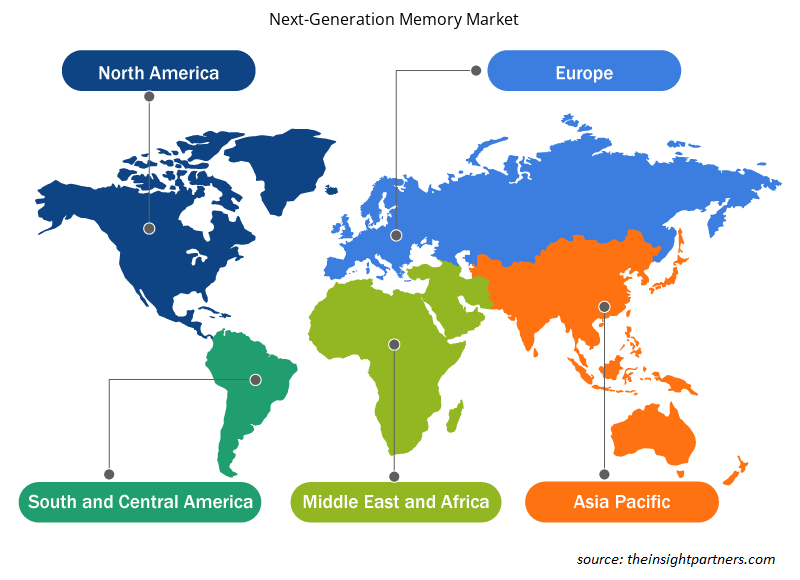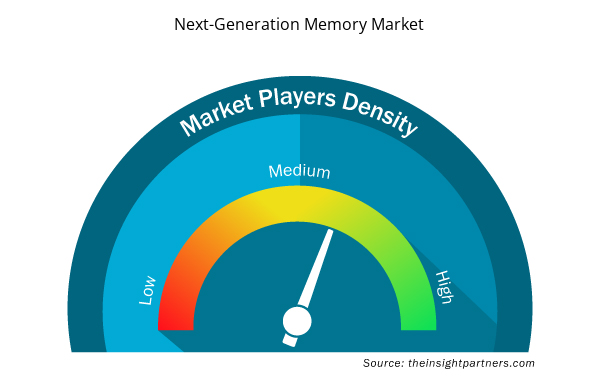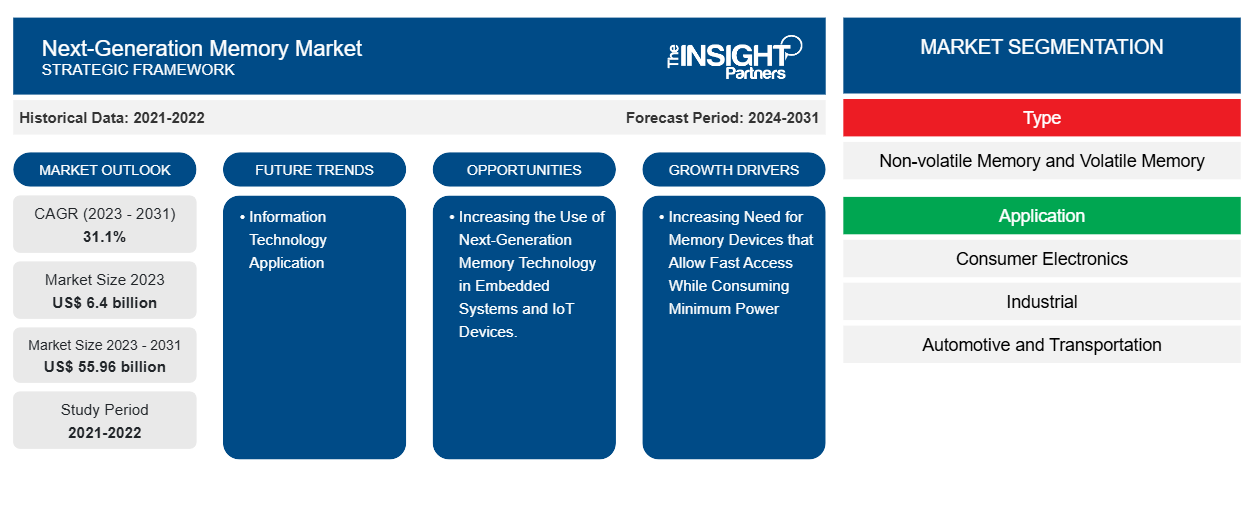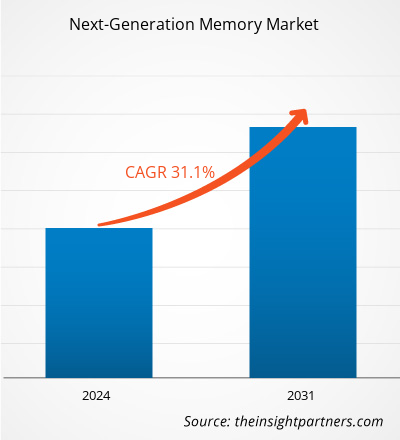من المتوقع أن يصل حجم سوق ذاكرة الجيل التالي إلى 55.96 مليار دولار أمريكي بحلول عام 2031 من 6.4 مليار دولار أمريكي في عام 2023. ومن المتوقع أن يسجل السوق معدل نمو سنوي مركب بنسبة 31.1٪ في الفترة 2023-2031. يتوسع سوق ذاكرة الجيل التالي بسبب الطلب المتزايد على الوصول السريع واستهلاك الطاقة المنخفض، فضلاً عن التبني المتزايد في تخزين المؤسسات والهواتف الذكية والأجهزة الذكية القابلة للارتداء.
تحليل سوق ذاكرة الجيل القادم
إن التقنيات الناشئة مثل التعلم الآلي (ML)، والذكاء الاصطناعي (AI)، وإنترنت الأشياء (IoT)، والبيانات الضخمة ، وما إلى ذلك، تدفع الطلب على أجهزة الذاكرة ذات النطاق الترددي العالي وقابلية التوسع واستهلاك الطاقة المنخفض. وهذا، إلى جانب الطلب المتزايد على تخزين الأعمال، هو أحد العوامل الأساسية التي تدفع نمو السوق.
نظرة عامة على سوق ذاكرة الجيل التالي
ذاكرة الجيل التالي هي نوع من تكنولوجيا ذاكرة الكمبيوتر المتطورة التي يتم تطويرها حاليًا. تتغلب هذه التطورات على قيود أنواع الذاكرة التقليدية مثل DRAM وNAND Flash. الهدف الرئيسي هو تحسين الجوانب الحاسمة لأداء الأعمال بشكل كبير، مثل السرعة والمتانة وكفاءة الطاقة وسعة التخزين. توفر هذه التقنيات غالبًا كثافة بيانات متزايدة، مما يسمح للشركات بتخزين المزيد من المعلومات في مساحة مادية أصغر. يمكن أن يساعد تبني هذه التقنيات المتقدمة الشركات على اكتساب ميزة تنافسية من خلال السماح بمعالجة البيانات بشكل أسرع وأكثر كفاءة، وهو أمر بالغ الأهمية في صناعة اليوم التي تعتمد على البيانات.
قم بتخصيص هذا التقرير ليناسب متطلباتك
ستحصل على تخصيص لأي تقرير - مجانًا - بما في ذلك أجزاء من هذا التقرير، أو تحليل على مستوى الدولة، وحزمة بيانات Excel، بالإضافة إلى الاستفادة من العروض والخصومات الرائعة للشركات الناشئة والجامعات
- احصل على أهم اتجاهات السوق الرئيسية لهذا التقرير.ستتضمن هذه العينة المجانية تحليلاً للبيانات، بدءًا من اتجاهات السوق وحتى التقديرات والتوقعات.
محركات وفرص سوق ذاكرة الجيل القادم
تزايد الحاجة إلى أجهزة ذاكرة تتيح الوصول السريع مع استهلاك الحد الأدنى من الطاقة لصالح السوق
مع قيام الشركات بتوليد المزيد من البيانات واستخدام التخزين السحابي، هناك طلب متزايد على ذاكرة تخزين سريعة وعالية السعة. إن التطورات في أداء المنتج تدفع قطاع أشباه الموصلات إلى الأمام. توفر تقنيات الذاكرة غير المتطايرة الناشئة، بما في ذلك RRAM وMRAM وFeRAM وNRAM، قابلية توسع وكثافة وسرعة وتحمل أعلى من التقنيات التقليدية، مما يلبي الطلب على السرعة العالية وانخفاض استهلاك الطاقة وقابلية التوسع. تتمتع تقنيات الذاكرة الناشئة عادةً بوقت استجابة يتراوح من 1 إلى 10 نانوثانية لتلبية متطلبات الأمر. يشير وقت التبديل إلى الوقت الذي تستغرقه الذاكرة لتلبية المتطلبات المحددة بعد الأمر.
زيادة استخدام تقنية الذاكرة من الجيل التالي في الأنظمة المضمنة وأجهزة إنترنت الأشياء.
زيادة اعتماد تقنية الذاكرة من الجيل التالي في الأنظمة المضمنة. يوفر الاستبدال المتزايد للذواكر التقليدية بذواكر من الجيل التالي فرصة كبيرة للمشاركين في الصناعة. تتمتع MRAM وReRAM بقراءة عالية واستهلاك منخفض للطاقة وسرعات كتابة وعدم تقلب، مما يجعلها مثالية للأنظمة المضمنة وأجهزة إنترنت الأشياء. يمكن لهذه الذواكر تحسين قدرات التشغيل الفوري والاقتصاد في الطاقة والاحتفاظ بالبيانات في الأجهزة الذكية. يمكن لهذه الذواكر تحمل عدد كبير من دورات القراءة والكتابة دون تدهور. هذه القدرة ضرورية لإنترنت الأشياء والأجهزة المضمنة التي تتطلب تحديثات بيانات منتظمة للحفاظ على الموثوقية والعمر الافتراضي. توفر تقنيات الذاكرة من الجيل التالي، مثل MRAM وReRAM، زمن انتقال منخفض ووصول عالي السرعة، مما يتيح الحوسبة في الذاكرة.
تقرير تحليل تجزئة سوق ذاكرة الجيل التالي
إن القطاعات الرئيسية التي ساهمت في استخلاص تحليل سوق الذاكرة من الجيل التالي هي النوع والتطبيق.
- وفقًا للنوع، يتم تقسيم سوق الذاكرة من الجيل التالي إلى ذاكرة غير متطايرة وذاكرة متطايرة.
- حسب التطبيق، يتم تقسيم السوق إلى الإلكترونيات الاستهلاكية، والصناعية، والسيارات والنقل، وتخزين المؤسسات، والعسكرية والفضاء، والرعاية الصحية، وتكنولوجيا المعلومات والاتصالات، وغيرها.
تحليل حصة سوق ذاكرة الجيل التالي حسب المنطقة الجغرافية
ينقسم النطاق الجغرافي لتقرير سوق ذاكرة الجيل التالي بشكل أساسي إلى خمس مناطق: أمريكا الشمالية، ومنطقة آسيا والمحيط الهادئ، وأوروبا، والشرق الأوسط وأفريقيا، وأمريكا الجنوبية/أمريكا الجنوبية والوسطى. كانت منطقة أمريكا الشمالية من أوائل المستخدمين لتكنولوجيا الجيل التالي والبنية الأساسية. تساهم صناعة تكنولوجيا المعلومات بشكل كبير في الاقتصاد الأمريكي. تتطلب التقنيات المتطورة بسرعة وزيادة توليد البيانات عبر الشركات حلول معالجة أكثر كفاءة. تدفع هذه المتغيرات الطلب الإقليمي على سوق ذاكرة الجيل التالي.
رؤى إقليمية حول سوق ذاكرة الجيل القادم
لقد قام المحللون في Insight Partners بشرح الاتجاهات والعوامل الإقليمية المؤثرة على سوق ذاكرة الجيل التالي طوال فترة التوقعات بشكل شامل. يناقش هذا القسم أيضًا قطاعات سوق ذاكرة الجيل التالي والجغرافيا في جميع أنحاء أمريكا الشمالية وأوروبا ومنطقة آسيا والمحيط الهادئ والشرق الأوسط وأفريقيا وأمريكا الجنوبية والوسطى.

- احصل على البيانات الإقليمية المحددة لسوق ذاكرة الجيل التالي
نطاق تقرير سوق ذاكرة الجيل التالي
| سمة التقرير | تفاصيل |
|---|---|
| حجم السوق في عام 2023 | 6.4 مليار دولار أمريكي |
| حجم السوق بحلول عام 2031 | 55.96 مليار دولار أمريكي |
| معدل النمو السنوي المركب العالمي (2023 - 2031) | 31.1% |
| البيانات التاريخية | 2021-2022 |
| فترة التنبؤ | 2024-2031 |
| القطاعات المغطاة | حسب النوع
|
| المناطق والدول المغطاة | أمريكا الشمالية
|
| قادة السوق وملفات تعريف الشركات الرئيسية |
|
كثافة اللاعبين في سوق ذاكرة الجيل التالي: فهم تأثيرها على ديناميكيات الأعمال
يشهد سوق ذاكرة الجيل التالي نموًا سريعًا، مدفوعًا بالطلب المتزايد من المستخدم النهائي بسبب عوامل مثل تفضيلات المستهلك المتطورة والتقدم التكنولوجي والوعي المتزايد بفوائد المنتج. ومع ارتفاع الطلب، تعمل الشركات على توسيع عروضها والابتكار لتلبية احتياجات المستهلكين والاستفادة من الاتجاهات الناشئة، مما يؤدي إلى زيادة نمو السوق.
تشير كثافة اللاعبين في السوق إلى توزيع الشركات أو المؤسسات العاملة في سوق أو صناعة معينة. وهي تشير إلى عدد المنافسين (اللاعبين في السوق) الموجودين في مساحة سوق معينة نسبة إلى حجمها أو قيمتها السوقية الإجمالية.
الشركات الرئيسية العاملة في سوق ذاكرة الجيل التالي هي:
- سامسونج
- شركة ميكرون للتكنولوجيا
- فوجيتسو
- شركة إس كيه هاينكس
- شركة هونيويل الدولية
- شركة مايكرو شيب للتكنولوجيا
إخلاء المسؤولية : الشركات المذكورة أعلاه ليست مرتبة بأي ترتيب معين.

- احصل على نظرة عامة على أهم اللاعبين الرئيسيين في سوق ذاكرة الجيل التالي
أخبار سوق ذاكرة الجيل القادم والتطورات الأخيرة
يتم تقييم سوق ذاكرة الجيل التالي من خلال جمع البيانات النوعية والكمية بعد البحث الأولي والثانوي، والتي تتضمن منشورات الشركات المهمة وبيانات الجمعيات وقواعد البيانات. فيما يلي قائمة بالتطورات في السوق:
- في أغسطس 2023، أطلقت شركة SK Hynix Inc. المنافسة في سباق تكنولوجيا أشباه الموصلات بذاكرتها عالية النطاق الترددي (HBM) من الجيل التالي. نجحت شركة SK Hynix في تطوير منتج DRAM من الجيل الخامس، HBM3E، والذي تم تصميمه خصيصًا لتطبيقات الذكاء الاصطناعي عالية الأداء. HBM هو جهاز مفيد وعالي الأداء يعمل على تسريع معالجة البيانات من خلال التكامل الرأسي للعديد من DRAM، متفوقًا على DRAM التقليدية.
(المصدر: SK Hynix Inc، موقع الشركة الإلكتروني، 2023)
- في أكتوبر 2023،كشفت شركة سامسونج عن حلول الذاكرة من الجيل التالي في Memory Tech Day، بهدف لعب دور حيوي في توفير نماذج ذكاء اصطناعي متطورة لتطبيقات الحجم الهائل. وقد قدمت الشركة مجموعة من حلول الذاكرة المتطورة، بما في ذلك أحدث ذاكرة Shinebolt HBM3e، وحلول LPDDR5X CAMM2 المستندة إلى وحدات حزمة LPDDR، وAutoSSD القابل للفصل.
(المصدر: موقع شركة سامسونج، 2021)
تقرير سوق ذاكرة الجيل القادم: التغطية والنتائج المتوقعة
يوفر تقرير "حجم سوق ذاكرة الجيل التالي والتوقعات (2021-2031)" تحليلاً مفصلاً للسوق يغطي المجالات التالية:
- حجم السوق والتوقعات على المستويات العالمية والإقليمية والوطنية لجميع قطاعات السوق الرئيسية التي يغطيها النطاق
- ديناميكيات السوق مثل المحركات والقيود والفرص الرئيسية
- الاتجاهات المستقبلية الرئيسية
- تحليل مفصل لقوى PEST/Porter الخمس وSWOT
- تحليل السوق العالمي والإقليمي الذي يغطي اتجاهات السوق الرئيسية واللاعبين الرئيسيين واللوائح والتطورات الأخيرة في السوق
- تحليل المشهد الصناعي والمنافسة الذي يغطي تركيز السوق، وتحليل خريطة الحرارة، واللاعبين البارزين، والتطورات الأخيرة
- ملفات تعريف الشركة التفصيلية
- التحليل التاريخي (سنتان)، السنة الأساسية، التوقعات (7 سنوات) مع معدل النمو السنوي المركب
- تحليل PEST و SWOT
- حجم السوق والقيمة / الحجم - عالميًا وإقليميًا وقطريًا
- الصناعة والمنافسة
- مجموعة بيانات Excel



Report Coverage
Revenue forecast, Company Analysis, Industry landscape, Growth factors, and Trends

Segment Covered
This text is related
to segments covered.

Regional Scope
North America, Europe, Asia Pacific, Middle East & Africa, South & Central America

Country Scope
This text is related
to country scope.
الأسئلة الشائعة
The global next-generation memory market was estimated to be US$ 6.4 billion in 2023 and is expected to grow at a CAGR of 31.1% during the forecast period 2023 - 2031.
The increasing need for memory devices that allow fast access while consuming minimum power is the major factors that propel the global next-generation memory market.
Information technology applications to play a significant role in the global next-generation memory market in the coming years.
The global next-generation memory market is expected to reach US$ 55.96 billion by 2031.
The key players holding the majority of shares in the global next-generation memory market are Samsung, Micron Technology, Inc., Fujitsu, SK HYNIX INC., and Honeywell International Inc.
Trends and growth analysis reports related to Electronics and Semiconductor : READ MORE..
The Insight Partners performs research in 4 major stages: Data Collection & Secondary Research, Primary Research, Data Analysis and Data Triangulation & Final Review.
- Data Collection and Secondary Research:
As a market research and consulting firm operating from a decade, we have published and advised several client across the globe. First step for any study will start with an assessment of currently available data and insights from existing reports. Further, historical and current market information is collected from Investor Presentations, Annual Reports, SEC Filings, etc., and other information related to company’s performance and market positioning are gathered from Paid Databases (Factiva, Hoovers, and Reuters) and various other publications available in public domain.
Several associations trade associates, technical forums, institutes, societies and organization are accessed to gain technical as well as market related insights through their publications such as research papers, blogs and press releases related to the studies are referred to get cues about the market. Further, white papers, journals, magazines, and other news articles published in last 3 years are scrutinized and analyzed to understand the current market trends.
- Primary Research:
The primarily interview analysis comprise of data obtained from industry participants interview and answers to survey questions gathered by in-house primary team.
For primary research, interviews are conducted with industry experts/CEOs/Marketing Managers/VPs/Subject Matter Experts from both demand and supply side to get a 360-degree view of the market. The primary team conducts several interviews based on the complexity of the markets to understand the various market trends and dynamics which makes research more credible and precise.
A typical research interview fulfils the following functions:
- Provides first-hand information on the market size, market trends, growth trends, competitive landscape, and outlook
- Validates and strengthens in-house secondary research findings
- Develops the analysis team’s expertise and market understanding
Primary research involves email interactions and telephone interviews for each market, category, segment, and sub-segment across geographies. The participants who typically take part in such a process include, but are not limited to:
- Industry participants: VPs, business development managers, market intelligence managers and national sales managers
- Outside experts: Valuation experts, research analysts and key opinion leaders specializing in the electronics and semiconductor industry.
Below is the breakup of our primary respondents by company, designation, and region:

Once we receive the confirmation from primary research sources or primary respondents, we finalize the base year market estimation and forecast the data as per the macroeconomic and microeconomic factors assessed during data collection.
- Data Analysis:
Once data is validated through both secondary as well as primary respondents, we finalize the market estimations by hypothesis formulation and factor analysis at regional and country level.
- Macro-Economic Factor Analysis:
We analyse macroeconomic indicators such the gross domestic product (GDP), increase in the demand for goods and services across industries, technological advancement, regional economic growth, governmental policies, the influence of COVID-19, PEST analysis, and other aspects. This analysis aids in setting benchmarks for various nations/regions and approximating market splits. Additionally, the general trend of the aforementioned components aid in determining the market's development possibilities.
- Country Level Data:
Various factors that are especially aligned to the country are taken into account to determine the market size for a certain area and country, including the presence of vendors, such as headquarters and offices, the country's GDP, demand patterns, and industry growth. To comprehend the market dynamics for the nation, a number of growth variables, inhibitors, application areas, and current market trends are researched. The aforementioned elements aid in determining the country's overall market's growth potential.
- Company Profile:
The “Table of Contents” is formulated by listing and analyzing more than 25 - 30 companies operating in the market ecosystem across geographies. However, we profile only 10 companies as a standard practice in our syndicate reports. These 10 companies comprise leading, emerging, and regional players. Nonetheless, our analysis is not restricted to the 10 listed companies, we also analyze other companies present in the market to develop a holistic view and understand the prevailing trends. The “Company Profiles” section in the report covers key facts, business description, products & services, financial information, SWOT analysis, and key developments. The financial information presented is extracted from the annual reports and official documents of the publicly listed companies. Upon collecting the information for the sections of respective companies, we verify them via various primary sources and then compile the data in respective company profiles. The company level information helps us in deriving the base number as well as in forecasting the market size.
- Developing Base Number:
Aggregation of sales statistics (2020-2022) and macro-economic factor, and other secondary and primary research insights are utilized to arrive at base number and related market shares for 2022. The data gaps are identified in this step and relevant market data is analyzed, collected from paid primary interviews or databases. On finalizing the base year market size, forecasts are developed on the basis of macro-economic, industry and market growth factors and company level analysis.
- Data Triangulation and Final Review:
The market findings and base year market size calculations are validated from supply as well as demand side. Demand side validations are based on macro-economic factor analysis and benchmarks for respective regions and countries. In case of supply side validations, revenues of major companies are estimated (in case not available) based on industry benchmark, approximate number of employees, product portfolio, and primary interviews revenues are gathered. Further revenue from target product/service segment is assessed to avoid overshooting of market statistics. In case of heavy deviations between supply and demand side values, all thes steps are repeated to achieve synchronization.
We follow an iterative model, wherein we share our research findings with Subject Matter Experts (SME’s) and Key Opinion Leaders (KOLs) until consensus view of the market is not formulated – this model negates any drastic deviation in the opinions of experts. Only validated and universally acceptable research findings are quoted in our reports.
We have important check points that we use to validate our research findings – which we call – data triangulation, where we validate the information, we generate from secondary sources with primary interviews and then we re-validate with our internal data bases and Subject matter experts. This comprehensive model enables us to deliver high quality, reliable data in shortest possible time.


 احصل على عينة مجانية لهذا التقرير
احصل على عينة مجانية لهذا التقرير